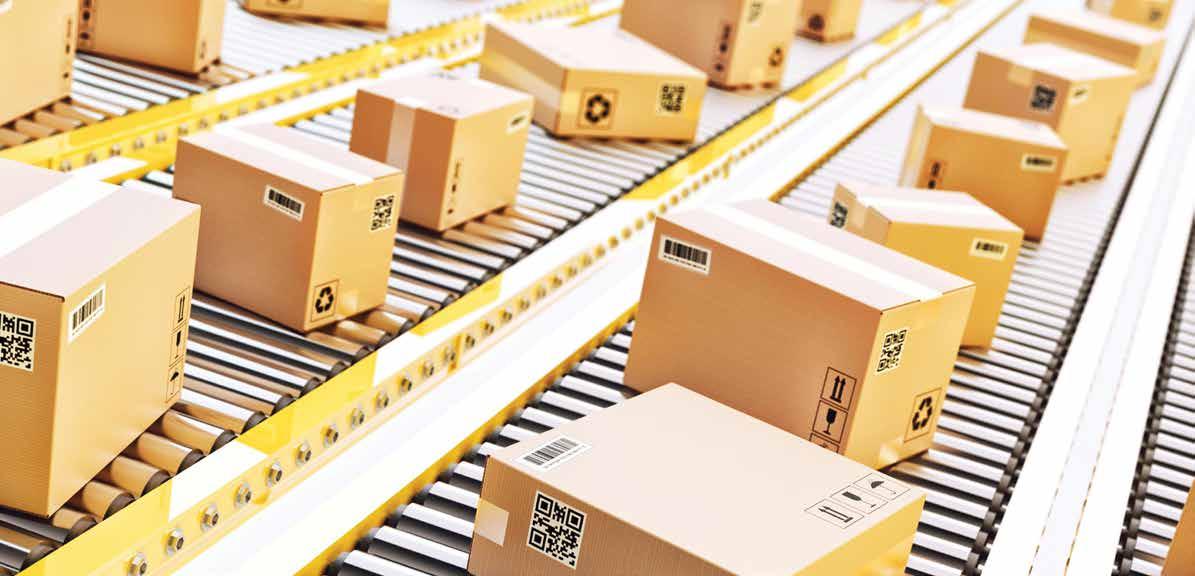
5 minute read
From Bricks and Mortar to Clicks and Orders
from SPN April 2023
by spnews.com
How E-Commerce Has Transformed the Packaging Sector.
From the desk of Steve Gislam
Advertisement
Anyone who remembers the world in the pre-digital age, has surely taken a moment to step back and take a look at the deep and profound impact the internet and digitalisation has had on all aspects of our lives. In just 25 short years, it has fundamentally altered almost every facet of human activity, including how we spend our money.
Indeed, the rise of e-commerce has changed how we consume completely, and it has taken the packaging industry along with it. It’s a trend that started in the late 1990s, continued steadily upwards over the subsequent two decades, and then rapidly accelerated during the Covid-19 lockdowns - which inadvertently offered an unprecedented boost to both sectors.
Today, record numbers of people are shopping online for everything from food to clothes to household appliances and, as a consequence, the world has never seen such a high volume of parcels. And where there are parcels, there’s packaging. So just how has the increased popularity of e-commerce impacted the packaging sector?
An increase in demand
The most obvious impact of the rise of e-commerce has been the significant increase in the volume of packages being shipped. According to global shipping firm Pitney Bowes Parcel Shipping Index 2022, 159 billion parcels were shipped worldwide in 2021. That equates to an increase of 440% since 2013.
Inevitably this massive surge in demand for shipped products has led to a higher demand for packaging materials as more online retailers need to package and ship their products, making sure they arrive at their customers’ doorsteps in good condition. In turn, this surge in demand has led to an increase in the production of packaging materials such as bubble wrap, corrugated cardboard boxes, air pillows and a range of other protective materials.
The packaging industry has responded to this demand by increasing production to meet the needs of e-commerce companies. According to a report by Smithers Pira, global demand for packaging materials is expected to reach $1.05 trillion by 2024, with e-commerce being one of the key drivers of this growth.

Changes in packaging design
The design of packaging has also evolved in response to the rise in popularity of e-commerce. It is even more important than ever that packaging is designed with the protection of products during shipping and handling in mind. Inappropriate packaging leads to damaged contents, which leads to more products being returned, and that’s bad for business for everyone involved.
Packaging aesthetics have always been an important part of a product’s marketing, but arguably the rise of e-commerce has made it more important than ever. In an increasingly busy marketplace, a product’s packaging also needs to stand out and be visually appealing to customers.
Packaging designs that are flat, lightweight, and easy to assemble are becoming more popular, as they can save on shipping costs. For example, Amazon has developed its own packaging designs that are optimised for its fulfilment process. These designs are flat and require minimal assembly, making them more efficient to pack and ship, whilst also keeping down costs.
Packaging designers should also be working with consumers’ needs in mind. A study carried out by Filtrona Tapes looked at the top frustrations that consumers have with packaging. Coming in top, 58% of respondents felt that over-packing was their biggest frustration. A further 43% complained that packaging was difficult to recycle. This leads us on to the third way that the rise of e-commerce has transformed the packaging sector: sustainability.
The shift towards sustainability
The importance of the move towards a more sustainable packaging sector cannot be overemphasised. It’s been a long time coming, and a trend that was being fuelled by rising concerns over climate change, and then turbocharged by the events of the Covid-19 pandemic and subsequent lockdowns. Consumers are more aware than ever before over the environmental impact that their purchases – and how those choices are packaged - can have. There are two main focal points here: the volume of packaging, and the types of materials they are made from.
While excessive and unnecessary packaging may be visually appealing, it nonetheless pushes up costs for manufacturers and e-commerce outlets. What’s more, overuse of packaging can ultimately be damaging to a brand’s reputation in a world moving towards sustainability. Customers don’t want to feel that their online purchases are contributing unduly to climate change. Less is more, is becoming one of the new normal of the post-Covid era.
Some e-commerce companies are implementing programmes that aim
To Reduce Waste
and
Encourage
recycling. For example, Amazon has launched its “Frustration-Free Packaging” programme, which aims to reduce excess packaging and make it easier for customers to recycle.

In terms of materials, plastic – once considered a wonder material – has in recent years been garnering an ever-worse name for itself. Gruesome images of plastics being removed from the stomachs of dead seabirds and fish have had a powerful impact on the public psyche.
To combat this, e-commerce companies are increasingly switching to alternative, more eco-friendly materials such as recycled paper and biodegradable plastics. This not only reduces the environmental impact, but it sends a strong signal to consumers about a company’s green credentials. Some firms are going a step further and are investing in innovative, new packaging designs that use less material or can be recycled more easily. Plant-based materials such as bamboo and mushroom-based packaging are ones to watch here.
Overall, it’s a tricky balancing act for packaging designers. They need to find the sweet spot between creating packaging that is practical and aesthetically pleasing, whilst being inexpensive to produce and ship, as well as environmentally sound.
Advancements in packaging technology
The continued rise of e-commerce has also driven innovations in packaging technology. For example, new packaging machines have been developed that can quickly and efficiently produce custom-sized boxes to fit specific products. This reduces the volume of packaging required and helps save on shipping costs.
Additionally, nascent technologies like Augmented Reality (AR) are already being used to enhance the customer experience by allowing them to see what products will look like in a real life setting before going ahead with the purchase.

For example, IKEA is using AR to enable customers to see what different items of furniture will look in their homes before they buy. Fashion brand Gucci has added an AR feature to its iOS app that allows customers to “try on” shoes virtually from their homes. This tech-based approach can help reduce returns and improve customer satisfaction and is highly likely to be utilised more often as the technology continues to develop.
Conclusion
It’s difficult to overstate the significant impact that e-commerce has had on the packaging industry. It has driven evolutions in packaging design, materials, and technology. Indeed, the fortunes of the two sectors now appear to be intrinsically linked.
While the worst horrors of the Covid-19 pandemic are largely behind us, e-commerce is continuing its upwards trajectory. As such, we can expect to see further innovations and developments in the packaging sector to meet the evolving needs of online retailers and their customers.











